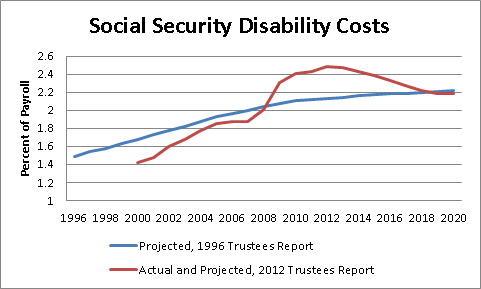March 25, 2013
Last week This American Life had a piece on the increase in the number of people on Social Security disability. While the segment had many interesting stories, and presented useful background, it got some of the basics wrong.
While the story did note the impact of the economic downturn on disability claims, it failed to recognize the actual importance of the economic collapse. Instead the piece turned to a variety of other explanations, for example citing the 1996 welfare reform bill.
If we go back to the projections in the 1996 Social Security trustees report, the disability program was projected to cost 1.93 percent of payroll in 2005. As it turned out, the program cost just 1.85 percent of payroll in 2005, about 4 percent less than the trustees had projected in 1996. The program’s cost did explode in the downturn, rising to 2.43 percent of payroll in 2011, with a projection of 2.48 percent of payroll for last year.

Social Security Trustees Reports, 1996 and 2012.
However the explanation for this increase seems pretty clear — the economy is down almost 9 million jobs from its trend growth path. People who would have otherwise been employed find themselves desperate for any means of support due to the inept economic policy that sank the economy. This is a simple explanation that doesn’t require examining the moral turpitude of beneficiaries or evidence of corrupt or negligent administrators. Fix the economy and you would remove much of the burden on the program. It is also striking that the projections in the 2012 Trustees Report show the costs again falling below the level projected in 1996 once the unemployment rate gets back down to a more normal level.
Of course that doesn’t mean the program was working perfectly before the economic collapse. There were undoubtedly many people getting disability payments who should not have been and also many people who were wrongly denied benefits. The system is grossly understaffed. As a result, many claims take way too long to be processed and often the wrong decision is made.
However, it seems more than a bit of a reach to explain expanding disability roles on some of the items covered in the segment. For example, the welfare reform bill was passed after the projections in the 1996 Trustees report were made. Yet, in 1996 the trustees still projected that disability would cost more a decade later than turned out to be the case. If welfare reform had the effect discussed in the segment, the error should have been in the other direction.
As we say here in the nation’s capitol, it’s the economy, stupid.







Comments